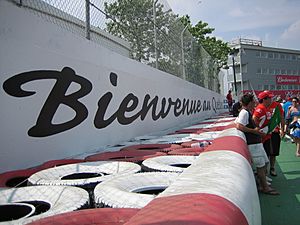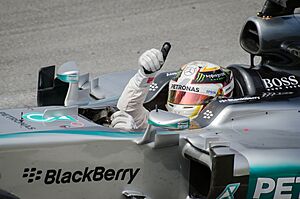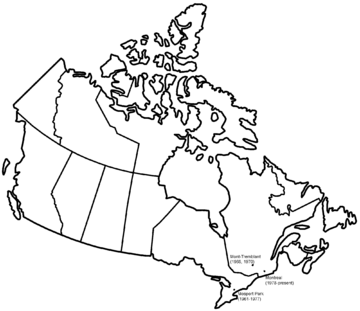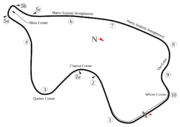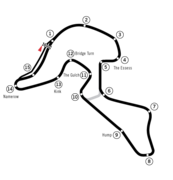Canadian Grand Prix facts for kids
| Circuit Gilles Villeneuve | |
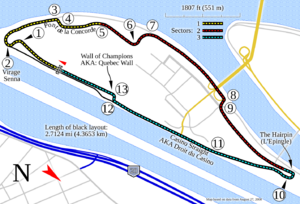 |
|
| Race information | |
|---|---|
| Number of times held | 60 |
| First held | 1961 |
| Most wins (drivers) | |
| Most wins (constructors) | |
| Circuit length | 4.361 km (2.709 mi) |
| Race length | 305.270 km (189.694 mi) |
| Laps | 70 |
| Last race (2025) | |
| Pole position | |
|
|
| Podium | |
|
|
| Fastest lap | |
|
|
The Canadian Grand Prix (which means "Grand Prix of Canada" in French) is an exciting annual car race. It has been held every year since 1961. Since 1967, it has been a part of the Formula One World Championship, which is the highest class of international racing.
The first races took place at Mosport Park in Ontario. It was originally a sports car event. Later, it alternated between Mosport and Circuit Mont-Tremblant in Quebec. Because of safety concerns, the race moved permanently to Mosport after 1971. In 1978, due to more safety worries at Mosport, the Canadian Grand Prix moved to its current home. This is the Circuit Gilles Villeneuve on Notre Dame Island in Montreal, Quebec.
The Canadian Grand Prix is very popular. In 2005, it was the most watched Formula One race in the world. It was also the third most watched sporting event globally that year. The races in 2020 and 2021 were cancelled because of the COVID-19 pandemic. The Canadian Grand Prix returned in the 2022 season. The contract to host the race was extended in 2025, meaning it will continue until 2035.
Contents
History of the Canadian Grand Prix
The early Canadian Grand Prix was a top event in the new Canadian Sports Car Championship. This series started at Mosport Park near Toronto in 1961. Mosport Park was a challenging track with many ups and downs. Drivers really liked it. Many international sports car and Formula One drivers raced there. For the first five years, drivers who had Formula One experience or would later join F1 won the event. In 1966, the Canadian-American Challenge Cup ran the event. American Mark Donohue won that year. Formula One took over the race the next year.
Formula One Racing Begins
Early Tracks: Mosport Park and Mont-Tremblant (1967-1977)
The Canadian Grand Prix became part of the Formula One World Championship in 1967. Mosport Park was the first venue for this. The race then alternated with Circuit Mont-Tremblant in Quebec. Mont-Tremblant, located northwest of Montreal, was also a challenging track with big elevation changes.
The first championship race was held on August 27, 1967. Jack Brabham won, with his teammate Denny Hulme finishing second. In 1968, the race moved to late September. Chris Amon led for most of the race but had to stop due to a gearbox problem. Denny Hulme and Bruce McLaren finished first and second for the McLaren team.
In 1969, at Mosport Park, Briton Jackie Stewart was battling Jacky Ickx. They tried to lap a slower driver, Al Pease, for the fourth time. Stewart and Ickx crashed. Ickx managed to continue and won. Pease was later disqualified for being too slow. He is the only F1 driver ever disqualified for this reason.
Jacky Ickx won again in 1970, with Ferrari teammate Clay Regazzoni in second. After 1970, Mont-Tremblant was no longer used for Formula One. This was due to safety concerns about the track surface and a dispute with local racing officials. So, Mosport Park became the only host for the Canadian Grand Prix from 1971.
The 1971 race at Mosport Park was very wet and foggy. Jackie Stewart won easily. In 1972, Mosport was improved with new safety features, and Stewart won again. The 1973 race was also rainy and confusing. After a safety car period, American Peter Revson ended up winning. In 1974, Emerson Fittipaldi won. There was no race in 1975. In 1976, Briton James Hunt won the event.
In 1977, French-Canadian driver Gilles Villeneuve made his debut for Ferrari. However, safety concerns about Mosport Park grew. Driver Ian Ashley had a terrible accident, and rescue efforts were slow. Another driver, Jochen Mass, hit a guardrail that flattened. These incidents showed Mosport was not safe enough. Jody Scheckter won this race.
Because of these safety issues, a new plan was made. The race sponsor, Labatt, and Mosport's owners tried to move the race to Toronto. But Toronto city council said no. Within hours, Montreal's mayor, Jean Drapeau, arranged for the race to move to Montreal permanently. A new track was quickly built on Notre Dame Island. This island was created for the famous Expo '67. Roads on the island were combined and changed to make a temporary race track. The Canadian Grand Prix has been held there ever since, starting in 1978.
Montreal's Circuit Gilles Villeneuve (1978-Present)
The first winner in Montreal was Quebec native Gilles Villeneuve, driving for Ferrari. In 1979, the track was made faster, and Australian Alan Jones won. He also won the 1980 race and the Drivers' Championship that year. The 1980 race also had a big crash at the start.
The 1981 race was very wet. Gilles Villeneuve showed amazing car control. His Ferrari's front wing was damaged from a crash, but he still drove to finish third. Frenchman Jacques Laffite won the race.
Sadly, Gilles Villeneuve died in 1982 during a qualifying lap for another race. A few weeks later, the Montreal race track was renamed Circuit Gilles Villeneuve in his honor. He was the first person inducted into the Canadian Motorsport Hall of Fame. He is also the only Canadian to win the Formula One Canadian Grand Prix.
The 1982 Canadian Grand Prix was a sad event after Villeneuve's death. Another accident happened when Villeneuve's teammate Didier Pironi stalled at the start. Riccardo Paletti crashed into the back of Pironi's car. Paletti was seriously injured and later died in the hospital. Nelson Piquet won the race. In 1982, the race also moved from October to June, where it has been held ever since.
In 1983, René Arnoux won for Ferrari. In 1984, Nelson Piquet won again. Ferrari finished first and second in 1985. In 1986, Nigel Mansell won a competitive race. The race was not held in 1987 due to a dispute between two sponsors. During this break, the track was changed, and the starting line moved to its current spot.
In 1988, Brazilian Ayrton Senna won. In 1989, Senna's engine failed, and Thierry Boutsen won his first F1 race. The 1990 race was rainy and had many accidents; Senna won again. The 1991 race had a dramatic ending. Nigel Mansell's car failed on the very last lap, just before the finish line. Nelson Piquet took his final F1 victory. Gerhard Berger won in 1992.
Alain Prost won in 1993. In 1994, the very fast Droit du Casino corner was changed into a chicane for safety. Michael Schumacher won this race. Ferrari's Jean Alesi won the 1995 race on his 31st birthday. This was his only career win. Alesi's victory was very popular, especially since his car number 27 once belonged to Gilles Villeneuve at his home Grand Prix. Schumacher even gave Alesi a ride back to the pits after Alesi's car ran out of fuel.
The Canadian Grand Prix became very important around this time. It was the only North American Grand Prix from 1993 to 2000, and again from 2008 to 2011.
The 1996 race saw more track changes. Damon Hill won this event. The 1997 race was stopped early due to a crash involving Olivier Panis. From 1997 to 2004, Michael Schumacher won many times for Ferrari. In 1999, Mika Häkkinen won. In 2001, Ralf and Michael Schumacher became the first brothers to finish first and second in Formula 1 history. They did it again in 2003.
The 2007 race was special because it was rookie Lewis Hamilton's first win. The race also saw a bad crash involving Robert Kubica. Kubica later won the race the following season, which was his only F1 win.
Race Not Held in 2009
On October 7, 2008, the Canadian Grand Prix was removed from the 2009 Formula One calendar. This was the first time since 1987 that the Montreal race was not held. This meant no Formula One race took place in North America in 2009.
Reports later suggested the Canadian Grand Prix might return. On August 29, 2009, the BBC reported that the race was provisionally scheduled for the 2010 season. On November 27, 2009, officials announced a new five-year contract. The Canadian Grand Prix returned to Montreal on June 13, 2010.
Recent Races (2010-Present)
The 2011 Canadian Grand Prix became the longest Formula One race ever. Rainstorms delayed the race for hours. When it restarted, Briton Jenson Button came from last place to win. He passed Sebastian Vettel on the last lap. Button called it "my best ever race."
The 2013 Canadian Grand Prix saw Sebastian Vettel dominate. However, it also had a sad event. Track marshal Mark Robinson was hit by a recovery vehicle. He died later in the hospital. This was the first track-side death in Formula One since 2001.
In 2025, George Russell won the Canadian Grand Prix for Mercedes.
Wildlife on the Track
Sometimes, animals appear on the race track! City officials try to trap groundhogs around the circuit before the Grand Prix. They move the animals to a nearby island. Still, groundhogs have caused problems.
- In 1990, Alessandro Nannini hit a gopher, damaging his tire.
- In 2007, a groundhog disrupted a practice session for Ralf Schumacher.
- On race day in 2007, Anthony Davidson hit a groundhog. This forced him to pit and fix his car.
- In 2018, Romain Grosjean hit a groundhog during practice, damaging his front wing.
- In 2022, Nicholas Latifi hit a groundhog during practice.
- In 2025, Lewis Hamilton hit a groundhog during the race. This left a hole in his car's floor.
The Wall of Champions
The very last corner of the Circuit Gilles Villeneuve is famous for crashes. Many former World Champions have crashed into the wall there. In 1999, Damon Hill, Michael Schumacher, and Jacques Villeneuve all crashed into this same wall. It became known as the "Wall of Champions."
Other champions and top drivers have also crashed there. These include Ricardo Zonta, Juan Pablo Montoya, Carlos Sainz Jr., and Jenson Button. In 2011, 4-time F1 Champion Sebastian Vettel hit the wall during practice. In 2019, Kevin Magnussen also crashed into it during qualifying.
Winners of the Canadian Grand Prix
Drivers with Multiple Wins
Drivers in bold are racing in Formula One this season. A pink background means the event was not part of the Formula One World Championship.
| Wins | Driver | Years won |
|---|---|---|
| 7 | 1994, 1997, 1998, 2000, 2002, 2003, 2004 | |
| 2007, 2010, 2012, 2015, 2016, 2017, 2019 | ||
| 3 | 1982, 1984, 1991 | |
| 2022, 2023, 2024 | ||
| 2 | 1963, 1964 | |
| 1969, 1970 | ||
| 1971, 1972 | ||
| 1979, 1980 | ||
| 1988, 1990 | ||
| 2013, 2018 | ||
| Sources: | ||
Teams with Multiple Wins
Teams in bold are racing in Formula One this season. A pink background means the event was not part of the Formula One World Championship.
| Wins | Constructor | Years won |
|---|---|---|
| 14 | 1963, 1964, 1970, 1978, 1983, 1985, 1995, 1997, 1998, 2000, 2002, 2003, 2004, 2018 | |
| 13 | 1968, 1973, 1974, 1976, 1988, 1990, 1992, 1999, 2005, 2007, 2010, 2011, 2012 | |
| 7 | 1979, 1980, 1986, 1989, 1993, 1996, 2001 | |
| 5 | 2013, 2014, 2022, 2023, 2024 | |
| 2015, 2016, 2017, 2019, 2025 | ||
| 4 | 1967, 1969, 1982, 1984 | |
| 2 | 1961, 1962 | |
| 1971, 1972 | ||
| 1991, 1994 | ||
| Sources: | ||
Engine Manufacturers with Multiple Wins
Manufacturers in bold are competing in Formula One this season. A pink background means the event was not part of the Formula One World Championship.
| Wins | Manufacturer | Years won |
|---|---|---|
| 14 | 1963, 1964, 1970, 1978, 1983, 1985, 1995, 1997, 1998, 2000, 2002, 2003, 2004, 2018 | |
| 12 | 1968, 1969, 1971, 1972, 1973, 1974, 1976, 1977, 1979, 1980, 1991, 1994 | |
| 11 | 1999, 2005, 2007, 2010, 2011, 2012, 2015, 2016, 2017, 2019, 2025 | |
| 6 | 1989, 1993, 1996, 2006, 2013, 2014 | |
| 4 | 1986, 1988, 1990, 1992 | |
| 1982, 1984, 2001, 2008 | ||
| 2 | 1961, 1962 | |
| 1965, 1966 | ||
| 2023, 2024 | ||
| Sources: | ||
* Built by Cosworth, funded by Ford
** Between 1999 and 2005 built by Ilmor, funded by Mercedes
Winners by Year
A pink background means the event was not part of the Formula One World Championship.
Previous Race Tracks
See also
 In Spanish: Gran Premio de Canadá para niños
In Spanish: Gran Premio de Canadá para niños





